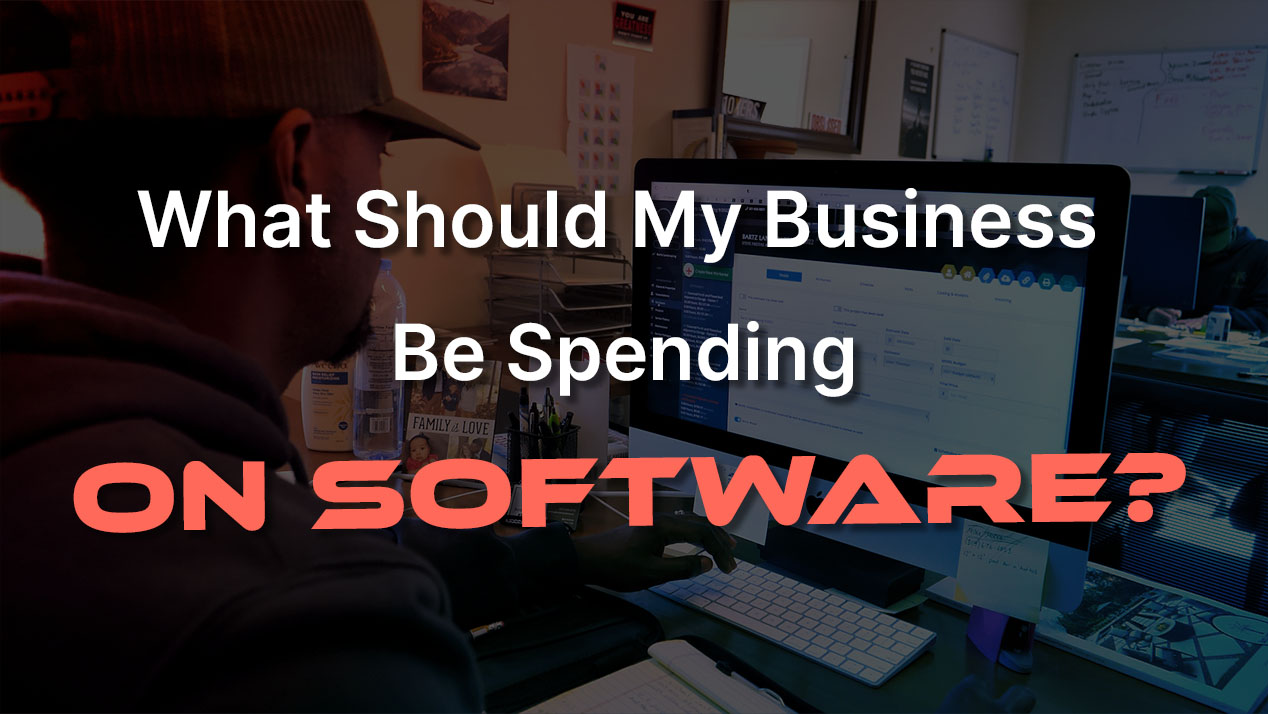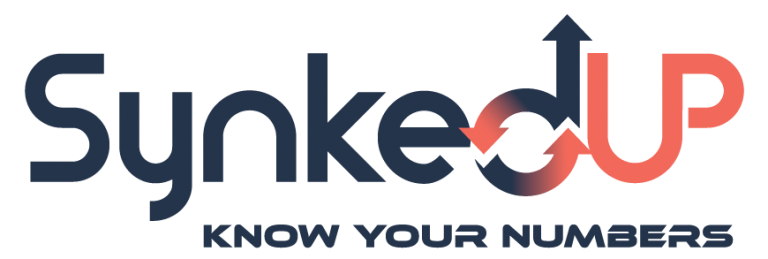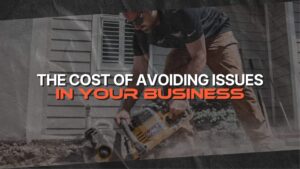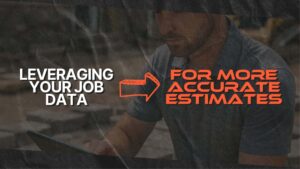What Should My Business Be Spending On Software?

What should my business be spending on software?
Ok, I’m finally going to do it. I’m focusing on the question of: What should my business be spending on software?
I’m sharing my philosophy and how I think about buying gadgets and tools for my business.
How much is too much? Is there such a thing as too much?
On one end of the spectrum, I run into folks who think paying for an app is like spending their “fun money”, or their profit.
On the other end of the spectrum, we have folks who seemingly buy everything they encounter.
Usually, the “I don’t wanna spend any money” guy ends up with a lot of manual inefficient processes, getting left in the dust by their competitors.
And usually the “I’ll buy anything that intrigues me” guy ends up with a lot of “shelfware”. Spending money on software collecting dust on the shelf. Not getting used.
Neither is good.
So what is the right way to think about it?
My philosophy
Like when buying anything, it’s gotta generate value. It’s no different when you’re trying to figure out what your business should be spending on software.
When you spend a dollar on a tool, that tool should make you $2-$10+ dollars back in ROI. Return on Investment.
If you buy a $100k machine, that machine can help you produce $1m worth of work.
When you hire an assistant for $20/hr, now you can go spend your time (which is worth more than $20/hr) on other higher-value tasks.
When you spend $500/mo on a software tool, it needs to generate 2X-10X+ more value than that in saved time, saved cash, or increased profitability.
All business investments, regardless of whether it’s an app, machine, or employee, boil down to creating an ROI on saved time or saving/making more money.
Spend a dollar to buy back your time.
Spend a dollar to make 2X-10X+ dollars
That’s it.
It’s as simple as that.
So, when making a buying decision on how much your business should be spending on software, I care less about the price tag, and more about the ROI it’ll generate.
I won’t spend a single dollar on a tool that doesn’t save me time or save/make more money.
But in theory, there is no limit or ceiling on what I’ll spend to save time or money, as long as the value of the saved time/money is greater than the price tag or investment.
The real question when deciding on spending on software
When trying to decide what your business should be spending on software, the real question is “What is the value of the saved time or money in relation to the price tag of the software (or tool, machine, hire, app, etc?”).
And once you have that answer, well, you may realize that every day you don’t make the investment, you are actually losing money in opportunity cost.
It could also be that the time or money that the investment saves or generates is not worth more than the price tag.
But we don’t want your “frugality” costing you money or wasted/inefficient time.
I’m not throwing shade at frugality. That’s a good and necessary trait.
Example: I may feel like “I can’t afford” a new truck.
But my old truck keeps breaking down. In fact, it broke down 5 times last year and cost me $15k in repair bills.
It cost me time and money.
It may be cheaper for me to buy a new or better truck, saving me the lost productive time on jobs, and the money on repair bills. The value of having a reliable truck that doesn’t prevent me from losing revenue-generating time on the job site, and doesn’t cost me crazy repair bills could be greater than the price tag of the new truck.
Reminder: It’s a mathematical equation, not an emotional one. Don’t rush out there and buy a new truck before you actually run the math. (Maybe I should’ve used a different example) 
Thought exercise
Ok, let’s practice this philosophy on whether or not you should buy SynkedUP for your business and team.
Does the software save or make you more money?
Dude, this one is a blast. Because I know SynkedUP crushes this one. Let’s start.
#1 Closing off cash leaks
One of the first things you do when spending on software like SynkedUP is build a company budget. Building a budget is essentially the act of telling the budget every dollar your business spends on it’s expenses. I can’t tell you how many times we’ve found out that the company was losing or not recovering over six figures in overlooked cash leaks.
It is so easy to miss these things in the hustle of growing a business. So many of your business’s expenses are “invisible” to your bank statement or Profit & Loss report. Things like equipment deprecation, unbillable labor, owner’s salary, as well as simply overlooked and forgotten overhead expenses like company t-shirts, small tools, etc.
One time I was helping a new SynkedUP user build his budget for the first time, and at the beginning of the call I asked him: “How much are your overhead expenses per year?” He told me “About $200k.” I remember thinking to myself, “Dude, you’re a $1.5m business, there’s no way.” I didn’t say anything and we just proceeded to build his budget. In the end, after we went over everything with a fine tooth comb and accounted for all overhead expenses, including the hidden and forgotten expenses, his overhead expenses came in over double what he had told me – $430k.
That was $230k of expenses he had not been recovering in his pricing for jobs and was essentially vanishing into thin air. His $5k investment for a year of SynkedUP saved him multi six figures on the first day.
#2 Fixing your business’s pricing
There are a lot of ways to get pricing your jobs wrong. It’s an extremely common pitfall. We base our pricing on what we think we’re worth. We look at the cheapest kid in town, look at the most established competitor, and plop our rates in the middle.
Or we take our direct costs of labor and material and double it for a 50% gross profit.
Or we negotiate with a client on the price of a job instead of the scope of work. Negotiating our profit away.
All of this stems from a lack of confidence.
There is incredible power in knowing your true breakeven on every job, and knowing without a shadow of a doubt that this is the right price for the job.
It doesn’t matter what the competitor is charging. It doesn’t matter that I feel that this is a lot of money. What matters is that I know that if I’m going to do this job, I have to have $—— to do the job profitably. Any less and I have no profit. And there’s no point in working for free.
SynkedUP’s budgeting tools give you the ability to charge exactly the right rates. Not too high and losing jobs you could’ve won. And not too low costing you profit.
Hint: I can tell you that 90% of the time, contractors are charging prices that are too low. With SynkedUP fixing their pricing, it takes them from working insanely hard for no profit to working calmly and strategically for great profits.
We regularly uncover pricing issues for new SynkedUP users, such as finding errors in sq ft pricing, incorrect markups in spreadsheets, and discovering that the hourly rate they had been selling for didn’t even allow them to break even. These are quickly fixed and profits are protected when pricing jobs through the SynkedUP system.
#3 Job Costing – knowing where you went wrong & where you went right
I’ve often compared the act of not job costing the jobs you complete (comparing estimated vs actual hours, expenses, and materials) to the act of taking a rifle to a shooting range, loading the gun, settling down on the sandbags, putting the cross-hairs of the scope right on the bullseye, and then slowly squeezing off the perfect shot, ….but then never looking where you hit.
Chamber another round, shoot again, …but never look where you hit. You could be completely missing the target! But you don’t know it.
That’s what failing to do job costing is like. You could be doing everything “correctly”. But if you never look where you hit, never check to see if you actually made money on that job, you’re blind.
And gut feeling doesn’t count. Sorry.
You need to know how much you made to the penny. How many hours & materials do you actually consume vs how many you had estimated?
It’s not that most contractors don’t think it’s worth it. They do. It’s just that with a machine breaking down, an employee not showing up, a customer complaint to address, you just simply don’t get it done. It gets pushed off the edge of your plate.
SynkedUP makes it easier so that the job costing just gets done for you behind the scenes. In real time.
The power of knowing your estimated vs actual hours, materials, etc in real-time is incredible. The quality of your learning as to why you went over/under hours and materials on that job goes way up. Makes it much easier to identify the mistake, and not repeat the same mistakes all year long.
Make the mistake once. Learn. Course correct on the next estimate. Make more profit. Shut off the chronic underbidding and cash leaks.
#4 Reducing missed billings
How many times have you “just thrown that in there” for your customer, but then forgot to bill them for it?
I know. Me too. I’ve done it. But you can stop it with SynkedUP.
SynkedUP will just keep track of your time and material on the job for you, so that when it comes time to bill, it’s easy peasy, click one button and shoot off the invoice. No more missed billings.
Does the software save you time?
#1 Saving time in estimating
It can take hours to put together a well done quote. The average SynkedUP user goes from 1-3 hrs per quote before SynkedUP, to 5-20 min after SynkedUP.
Talk about buying back your time.
When asking what your business should be spending on software, the better question to be asking is, “What’s your time worth?” Let’s say it’s worth $100 for easy math. (Get a quick and dirty calculation on what your hourly rate truly is here)
Now let’s say you do 20 quotes per month on average, and they usually take an hour. That’s 20 hours of your time.
Let’s insert SynkedUP and the power of templates and production rates, and get that average 1 hour per quote down to 15 min. (usually less) That saves 45 min per quote.
At 20 quotes per month x 45 min saved, that saves you 15 hrs a month. At $100/hr that’s $1,500 of your time you got back to redirect to higher value tasks. Or get more quotes out.
Or make it home in time for dinner for once.
#2 Reducing unbillable man-hours
Ever feel like your team is forgetting stuff, or planning poorly, making unnecessary runs to the supply yard, or back to the shop for something?
Well, solving that starts with providing the team with good info of what they need, materials, photos, address to the jobsite, etc, so that they can plan and mentally prep ahead of time.
SynkedUP’s digital job folder in the mobile app can reduce those unnecessary trips back to the shop, reducing unbillable time, and increasing productive time on site. Double whammy.
Summary
Here’s the thing when thinking about how much you should be spending on software…
Each one of these points above can more then pay for the price tag of having SynkedUP unleashed inside your business on their own!
And there’s what, 6 individual points!?
And so often we know it deep down in our gut, but we’re not sure what to do about it, or we tell ourselves it’s actually not that bad.
It’s not who works the hardest who wins.
The one who wins is the one who pays attention to this stuff.
Each of those points above can single handedly suck the profits right out of your business and make you go broke. I’ve seen it. It’s no joke.
And with SynkedUP deployed in your business, it can nip each of those profit killers in the bud.
Each one of those points, when corrected, would more than pay for the price of the software.
Which is why the average contractor to implement SynkedUP sees a 5X-10X and beyond return on their investment into SynkedUP.
The number one thing I hear after a contractor’s been using SynkedUP is:
“Dude I should’ve done this on day 1. I always told myself software was for “bigger” companies, but I should’ve done it right away. Every day I didn’t use SynkedUP was costing me money,”
It’s opportunity cost baby.
It’s as simple as asking – which is bigger?
The price tag?
Or the ROI?
Whichever is bigger, there’s your answer.
And when you take the plunge – use it.
The most expensive tool you can buy is the one you don’t use.
Cheers,
Weston Zimmerman
SynkedUP CEO and co-founder

Weston Zimmerman
CEO and co-founder
See SynkedUP in action
Related Articles
Why Time Tracking is Critical for Contractors
Cutting costs isn't the same as saving money. Learn how to use leverage, not panic, to drive real profit and...
Why Cutting Costs Isn’t the Same as Saving Money
Cutting costs isn't the same as saving money. Learn how to use leverage, not panic, to drive real profit and...
Slow Down to Speed Up
A quick leadership gut check: Are you building what really matters? Slow down, realign, and lead with intention.
The One Calculation Every Contractor Should Know
Contractors: If you’re not factoring in overhead, you're not pricing right. Learn how to calculate breakeven and stop guessing your...
What Owns Your Day? Urgency or Importance?
Stuck in a cycle of chaos and urgent tasks? Break the cycle with better systems, clear processes, and leadership that...
Taking Care of Your Team
Leadership isn't barking orders - it's listening, appreciating, and building problem solvers. Here's how to lead without burning out.
The Cost of Avoiding Issues in Your Business
Avoiding stuff in business adds up, with interest. Don't try harder, build systems that make success default. Do hard things,...
Leveraging Your Job Data for More Accurate Estimates
Stop estimating from the gut. Track time, collect job data, and turn it into faster, more accurate production rates.
How the Best Contractors Ensure Profitability
Running over estimated hours is one of the biggest silent profit killers in contracting. Here's how to track it, catch...
How To: Rank Higher on Google Search
Learn how to rank at the top of Google without spending thousands. This simple, free strategy levels the playing field...









